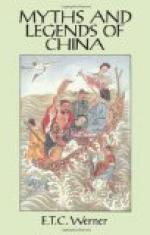The Cursed Temple
The reign of Ch’ung Cheng, the last monarch of the Ming dynasty, was much troubled both by internal broils and by wars. He was constantly threatened by Tartar hordes from without, though these were generally beaten back by the celebrated general Wu San-kuei, and the country was perpetually in a state of anarchy and confusion, being overrun by bands of marauding rebels; indeed, so bold did these become under a chief named Li Tzu-ch’eng that they actually marched on the capital with the avowed intention of placing their leader on the Dragon Throne. Ch’ung Cheng, on the reception of this startling news, with no one that he could trust in such an emergency (for Wu San-kuei was absent on an expedition against the Tartars), was at his wits’ end. The insurgents were almost in sight of Peking, and at any moment might arrive. Rebellion threatened in the city itself. If he went out boldly to attack the oncoming rebels his own troops might go over to the enemy, or deliver him into their hands; if he stayed in the city the people would naturally attribute it to pusillanimity, and probably open the gates to the rebels.
In this strait he resolved to go to the San Kuan Miao, an imperial temple situated near the Ch’ao-yang Men, and inquire of the gods as to what he should do, and decide his fate by ‘drawing the slip.’ If he drew a long slip, this would be a good omen, and he would boldly march out to meet the rebels, confident of victory; if a middle length one, he would remain quietly in the palace and passively await whatever might happen; but if he should unfortunately draw a short one he would take his own life rather than suffer death at the hands of the rebels.
Upon arrival at the temple, in the presence of the high officers of his Court, the sacrifices were offered up, and the incense burnt, previous to drawing the slip on which hung the destiny of an empire, while Ch’ung Cheng himself remained on his knees in prayer. At the conclusion of the sacrificial ceremony the tube containing the bamboo fortune-telling sticks was placed in the Emperor’s hand by one of the priests. His courtiers and the attendant priests stood round in breathless suspense, watching him as he swayed the tube to and fro; at length one fell to the ground; there was dead silence as it was raised by a priest and handed to the Emperor. It was a short one! Dismay fell on every one present, no one daring to break the painful, horrible silence. After a pause the Emperor, with a cry of mingled rage and despair, dashed the slip to the ground, exclaiming: “May this temple built by my ancestors evermore be accursed! Henceforward may every suppliant be denied what he entreats, as I have been! Those who come in sorrow, may that sorrow be doubled; in happiness, may that happiness be changed to misery; in hope, may they meet despair; in health, sickness; in the pride of life and strength, death! I, Ch’ung Cheng, the last of the Mings, curse it!”




